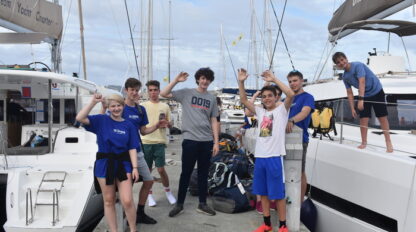Prepare a Moveable Feast

Good food is a sure way to avoid a mutiny at sea. The galley on a sailboat is an altar to efficiency, designed to minimize space but maximize utility. A two-burner stovetop, miniature oven, and compact counter space aren’t reasons to sacrifice your taste buds. And although almost everyone enjoys a fresh seafood catch of the day, don’t rely just on your fishing rod to whet your appetite. The prudent chef plans healthy, varied meals. With the right tools, prep, and plan, you can enjoy gourmet cuisine underway, spending less time below and more time on deck enjoying the finished product.
Provisioning

The first and most important step is stocking your stores properly. Canned goods go a long way and save money, but may not always satisfy your pallet on their own. To ensure for healthy, creative meal options, selectively supplant your floating pantry with fresh fruits, vegetables, meats, spices and herbs. Choose ingredients based upon preferences and allergies given by your crew prior to your trip to the market. When charting your course, take into account how many days you will be at sea, and plan provisioning stops along the way to replenish depleted supplies.
Storage
Most charter sailboats provide ample cupboard space. The only limiting factor in food storage is usually refrigerator capacity and design. There is only one correct way to pack this appliance: NEATLY. Store meat and dairy at the bottom, the coldest part of your onboard icebox. On top, place vegetables and bread. Separate and seal everything (double-bag with meats) to avoid unwanted leakage. Unpack and clean everyday, reevaluating each food groups’ status. Don’t be afraid to discard!

The Stove
Most sailboats have a gimbal stove, meaning it can rock back and forth with the waves. Keep in mind its limitations when choosing your menu. If the seas are big, it might be a better day for a quick stir-fry than an involved pasta dish. Save the fresh broiled fish for a night when you’re tucked away in a protected cove or on a slip.
Keeping your heat source in mind is also essential—small burners mean that heating pots or pans with large surface areas can take time. A boat stove gives new meaning to the old wisdom that a watched pot will never boil, so be sure to plan accordingly when a recipe requires boiling water.
Conserve heat by using a lid on your pot or pan. This helps water boil much faster, especially if it is a tight-fitting lid, and helps evenly distribute heat on meats and other ingredients that need to be cooked thoroughly. Reusing hot water from one part of the dish (like pasta or potatoes) when heating up another can also save time and water, vital resources when underway. If available, a pressure-cooker will increase the pressure in the pot by not allowing steam to escape, raising the boiling point of the water and cooking faster. Alternatively, save time and fuel and enhance flavor by steaming vegetables or other foods instead of boiling them.
3 Preparation Tips

- Whenever possible, prepare your ingredients in advance. This is especially important for defrosting frozen foods earlier in the day. Make a goal of having all chopping, washing, and prep complete along with a basic understanding of the recipe before you add anything to the pan. Work in teams and to music, two essential ingredients in enjoyable cooking!
- Remaining flexible with ingredients can also make a big difference—if you’re short on time, scrap the mashed potatoes plan and toss your tubers in the oven for a simple-to-make potatoes au gratin—letting the oven do the work and keeping the small stovetop open for preparing your main course.
- To maximize efficiency in the galley use as few utensils as possible. This will ensure a speedy post-meal cleanup. Wash as you go and you’ll be surprised how much more pleasant a meal can be when you know the cookware is already clean!
With a little practice and patience, you’ll be preparing meals on board that rival your finest culinary exploits at home. Try the delectable recipe below, one of the many our students create from the Sail Caribbean Cookbook:
PESTO PASTA
Approx Time: 45 mins
Difficulty: 2
| Ingredients | Directions |
|---|---|
| 2 boxes of fettuccini pasta | Boil 1/2 a pot of water, THEN add the pasta. |
| 1 pkg. of shredded cheese | Cook the pasta until it is soft but firm. |
| 1 cup of Parmesan | Drain off the water & put the pasta in a bowl. |
| 1 broccoli head diced | Toss with a little oil to keep from sticking. |
| 2 green peppers diced | Add the veggies to the cooking pot. |
| 2 tomatoes diced | Place 1/2 of the strips of cheese over veggies. |
| 1 carrot diced | Put the hot pasta on top of the veggies. |
| Parmesan or Pesto | Top pasta with more cheese & cover with top. |
| Let sit 5 minutes to melt the cheese the toss. | |
| Stir in butter and pesto or Parmesan to taste. |


